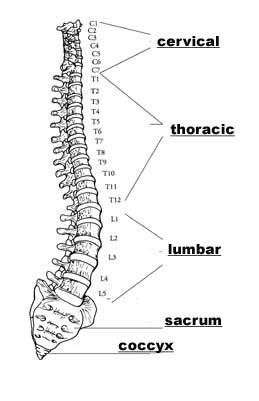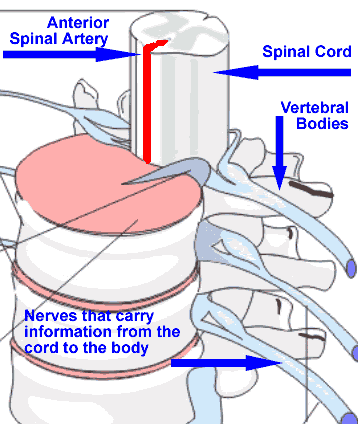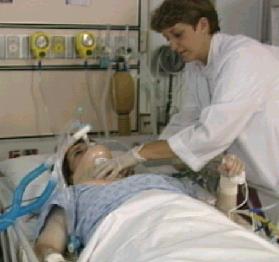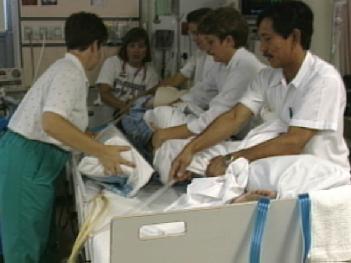|
CERVICAL SPINE; C-SPINES; The Cervical Spine, or "C-Spine" includes the first 7 bones (called vertebrae) of the spinal column (Image 1). The spinal cord is the large bundle of nerves that communicates information between the brain and the body. The vertebrae creates a long space or channel that runs almost the entire length of the vertebral column (the bony structure that makes up the spine) (Image 2). The vertebral column begins at the base of the brain and extends to the tail bone. The cervical vertebrae are located within the neck. Trauma or injury to the vertebrae can cause injury to the spinal cord (called an Acute Spinal Cord Injury). Spinal column damage can also occur without injury to cord. The spinal cord can also be damaged if the blood flow the spine is reduced. Spinal cord injury can be devastating, and can lead to paralysis (loss of movement) and parasthesia (loss of feeling) to the area of body that is below the level of the injury. Damage to the section of the cord that is contained within the cervical vertebrae is particularly devastating. Paralysis from injury at this level can produce quadriplegia (paralysis in the arms and the legs). Every breath that we takes occurs because the brain sends a message down a short section of the cervical spinal cord, where the message then travels to the phrenic nerves. The phrenic nerves cause the breathing muscles (including the diaphragm) to work. Injuries that are high in the cervical cord can prevent a patient from being able to breathe. An injury at this could leave the patient quadriplegic and dependant on a ventilator. Because of the significance of a cervical spine level injury, all trauma patients or patients with head injuries are presumed to have a neck injury until we have successfully ruled any injury out. Patients are cared for using Spinal Precautions. Bending or twisting the neck could suddenly cause a shift in the alignment of the neck that could injure the cord. Even if a cord injury has already occurred, the neck is kept in careful alignment to prevent the damage from involving a larger area of the cord. Patients will be cared for in a stiff neck collar to reduce the chance for movement. The hard pick collars are called "Philadelphia Collars". If a patient needs to wear a collar for a longer period of time, a softer collar "white with blue lining" may be used. If the patient needs to be placed in the second collar, the patient will be charged for this device. In addition to the cervical cord, injuries can occur in the middle segment of the spine (called the Thoracic or "T" Spine). The lower portion of the spinal column is called Lumbar spine. It is located in the abdominal and lower back region. Damage at the thoracic or lumbar level can produce paraplegia (paralysis of the legs; the arms are preserved). In addition to "neck" or "C-spine precautions", all trauma patients are cared for with thoracic and lumbar level protection. This is sometimes collectively called "C-T-L" precautions. Patients with spinal precautions are turned very carefully to prevent flexion or movement of the vertebrae. Several people will participate in the turn to ensure it remains smooth and protective of the spine. Patients can be turned side to side as long as the spine alignment is maintained. These turns are often referred to as "log-rolling" because the patient is rolled like a log.
|
Image 1: Vertebral Column |
|
Image 2: Vertebral Column |
|
|
|
|
|
Image 3: Philadelphia Neck Collar |
Image 4: Spinal Precautions, log roll |
|
|
Last Reviewed: October 23. 2014






